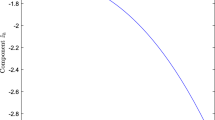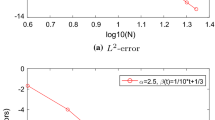Abstract
In this paper, we consider the nonlinear boundary value problems involving the Caputo fractional derivatives of order \(\alpha \in (1,2)\) on the interval (0, T). We present a Legendre spectral collocation method for the Caputo fractional boundary value problems. We derive the error bounds of the Legendre collocation method under the \(L^2\)- and \(L^\infty \)-norms. Numerical experiments are included to illustrate the theoretical results.










Similar content being viewed by others
References
Canuto, C., Hussaini, M.Y., Quarteroni, A., Zang, T.A.: Spectral Methods: Fundamentals in Single Domains. Springer, Berlin (2006)
Chen, S., Shen, J., Wang, L.L.: Generalized Jacobi functions and their applications to fractional differential equations. Math. Comput. 85, 1603–1638 (2016)
del-Castillo-Negrete, D., Carreras, B.A., Lynch, V.E.: Front dynamics in reaction–diffusion systems with Levy fights: a fractional diffusion approach. Phys. Rev. Lett. 91, 018302 (2003)
Diethelm, K.: The Analysis of Fractional Differential Equations: An Application-Oriented Exposition Using Differential Operators of Caputo Type, Lecture Notes in Mathematics, vol. 2004. Springer, Berlin (2010)
Ervin, V.J., Roop, J.P.: Variational formulation for the stationary fractional advection dispersion equation. Numer. Methods Partial Differ. Equ. 22, 558–576 (2006)
Esmaeili, S., Shamsi, M.: A pseudo-spectral scheme for the approximate solution of a family of fractional differential equations. Commun. Nonlinear Sci. Numer. Simul. 16, 3646–3654 (2011)
Ito, K., Jin, B., Takeuchi, T.: On a Legendre tau method for fractional boundary value problems with a Caputo derivative. Fract. Calc. Appl. Anal. 19, 357–378 (2016)
Jin, B., Lazarov, R., Pasciak, J., Rundell, W.: Variational formulation of problems involving fractional order differential operators. Math. Comput. 84, 2665–2700 (2015)
Jin, B., Lazarov, R., Pasciak, J., Zhou, Z.: Error analysis of a finite element method for the space-fractional parabolic equation. SIAM J. Numer. Anal. 52, 2272–2294 (2014)
Kilbas, A.A., Srivastava, H.M., Trujillo, J.J.: Theory and Applications of Fractional Differential Equations. Elsevier, Amsterdam (2006)
Kopteva, N., Stynes, M.: An efficient collocation method for a Caputo two-point boundary value problem. BIT 55, 1105–1123 (2015)
Li, C., Zeng, F., Liu, F.: Spectral approximations to the fractional integral and derivative. Fract. Calc. Appl. Anal. 15, 383–406 (2012)
Li, X., Xu, C.: A space-time spectral method for the time fractional diffusion equation. SIAM J. Numer. Anal. 47, 2108–2131 (2009)
Machado, J.T., Kiryakova, V., Mainardi, F.: Recent history of fractional calculus. Commun. Nonlinear Sci. Numer. Simul. 16, 1140–1153 (2011)
Mainardi, F.: Fractional Calculus and Waves in Linear Viscoelasticity: An Introduction to Mathematical Models. Imperial College Press, London (2010)
Mastroianni, G., Occorsto, D.: Optimal systems of nodes for Lagrange interpolation on bounded intervals: a survey. J. Comput. Appl. Math. 134, 325–341 (2001)
Mokhtary, P., Ghoreishi, F.: The \(L^2\)-convergence of the Legendre spectral tau matrix formulation for nonlinear fractional integro-differential equations. Numer. Algor. 58, 475–496 (2011)
Pedas, A., Tamme, E.: Piecewise polynomial collocation for linear boundary value problems of fractional differential equations. J. Comput. Appl. Math. 236, 3349–3359 (2012)
Shen, J., Tang, T., Wang, L.L.: Spectral Methods: Algorithms, Analysis and Applications, Springer Series in Computational Mathematics, vol. 41. Springer, Berlin (2011)
Tadjeran, C., Meerschaert, M.M., Scheffler, H.P.: A second-order accurate numerical approximation for the fractional diffusion equation. J. Comput. Phys. 213, 205–213 (2006)
Wang, H., Yang, D., Zhu, S.: Inhomogeneous dirichlet boundary-value problems of space-fractional diffusion equations and their finite element approximations. SIAM J. Numer. Anal. 52, 1292–1310 (2014)
Wang, Z.Q., Guo, Y.L., Yi, L.J.: An \(hp\)-version Legendre–Jacobi spectral collocation method for Volterra integro-differential equations with smooth and weakly singular kernels. Math. Comput. 86, 2285–2324 (2017)
Wang, Z.Q., Sheng, C.T.: An \(hp\)-spectral collocation method for nonlinear Volterra integral equations with vanishing variable delays. Math. Comput. 85, 635–666 (2016)
Author information
Authors and Affiliations
Corresponding author
Additional information
The research of Zhongqing Wang was supported by the National Natural Science Foundation of China (No. 11571238). The research of Lilian Wang was partially supported by Singapore MOE AcRF Tier 1 Grants (RG15/12 and RG27/15), and Singapore MOE AcRF Tier 2 Grant (MOE 2013-T2-1-095, ARC 44/13).
Appendix
Appendix
In this appendix, we verify the existence and uniqueness of scheme (3.7) with the Lipschitz constant \(L<\frac{\Gamma (\alpha +1)}{2T^{\alpha }}\). We consider the following iteration process:
Let \(\widetilde{U}^m(x)=U^m(x)-U^{m-1}(x).\) Then we have from (5.5) and (4.8) that
where
By (3.3), (4.4) and the Cauchy–Schwarz inequality, we derive that
Therefore, by (4.4), (4.13) and the Lipschitz condition, we further deduce that for \(L<\frac{\Gamma (\alpha +1)}{2T^{\alpha }},\)
We next estimate the term \(\Vert A_2\Vert \). By the Cauchy–Schwarz inequality, we know that
The previous result, along with (3.3) and the Lipschitz condition, yields
Hence
Since
we have \(\Vert \widetilde{U}^m\Vert \rightarrow 0\) as \(m\rightarrow \infty .\) This implies the existence of solution of (3.7). It is easy to prove the uniqueness of solution of (3.7).
Rights and permissions
About this article
Cite this article
Wang, C., Wang, Z. & Wang, L. A Spectral Collocation Method for Nonlinear Fractional Boundary Value Problems with a Caputo Derivative. J Sci Comput 76, 166–188 (2018). https://doi.org/10.1007/s10915-017-0616-3
Received:
Revised:
Accepted:
Published:
Issue Date:
DOI: https://doi.org/10.1007/s10915-017-0616-3
Keywords
- Spectral collocation method
- Caputo fractional derivative
- Fredholm integral equations
- Convergence analysis




